Trigonometric-parallax astronomy
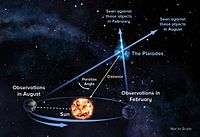
Trigonometric-parallax astronomy is the astronomy of conducting trigonometric parallax measurements to determine the distance to astronomical objects.
The image on the right shows the elementary aspects of parallax independent of the radiation used. Here, opposite ends of the Earth's orbit around the Sun are used to precisely measure the distance to an astronomical object.
Astronomy
Def. an "apparent shift in the position of two stationary objects relative to each other as viewed by an observer, due to a change in observer position"[1] is called a parallax.
Radiation
Parallax measurements can be made at any wavelength of electromagnetic radiation.
Theoretical parallax astronomy
The distance from a parallax measurement in pc is given by D = 1/p in arcseconds. The "standard deviation, which describes the 'typical' amount of error, is not negligible in comparison with the parallax. [...] the non-linearity of the relation causes the distribution function of the estimates [...] and thus the distribution function of the errors in distance [...] to be skewed."[2]
For example, the most recent parallax for χ Cyg is 5.53 ± 1.10. The skewness results when the distance is calculated D = 1/0.00553 = 181 pc, but this ranges from 151 to 226 or 181 +45 and -30 pc.
"Extreme values are less likely to appear in a small sample than in a larger one. The reason is that with a small sample it is not very probable that any of the sample parallaxes will have an absolute value close to zero. As the sample size is increased the absolute value nearest to zero will continually decrease and the corresponding very large value of [D] will drive up the sample variance. Furthermore, this anomalous value will more and more seriously distort the value of the sample mean. The increasingly erratic behaviour of the sample mean as sample size is increased contrasts with the behaviour of the mean for a Gaussian distribution, which more and more closely approaches the population mean with increasing sample size."[2]
Entities
"Physical entities are (almost) always characterized by a numerical parameter whose value can only be approached through some measuring process, by means of a statistical adjustment of a set of appropriate measurements. All that we can ever obtain is a best (in some prescribed sense) estimate of that value. By itself this estimate is, strictly speaking, meaningless, for it simply defines an interior point of a set of possible values; unless one has some estimate of the extremes of that set (to within some level of probability) in addition to the best estimate itself, one cannot exclude any value of that parameter. In many cases the probabilities of nearby values can be described by a function that is symmetric around the best estimate, and the parameter values bounding an interval (or a region if one happens to be dealing with multivariate analysis) which has a certain cumulative probability (usually 0.68) define an 'error bar' or error interval whose endpoints are equally distant from the best estimate."[2]
X-rays
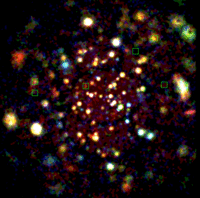
"The Pleiades star cluster is one of the jewels of the northern sky. To the unaided eye it appears as an alluring group of stars in the constellation Taurus, while telescopic views reveal cluster stars surrounded by delicate blue wisps of dust-reflected starlight. To the X-ray telescopes on board the orbiting ROSAT observatory, the cluster also presents an impressive, but slightly altered, appearance. This false color image was produced from ROSAT observations by translating different X-ray energy bands to visual colors - the lowest energies are shown in red, medium in green, and highest energies in blue. (The green boxes mark the position of the seven brightest visual stars.) The Pleiades stars seen in X-rays have extremely hot, tenuous outer atmospheres called coronas and the range of colors corresponds to different coronal temperatures."[3]
According to SIMBAD, M45 (the Pleiades) is located at "ICRS coord. (ep=J2000) : 03 47 00.0 +24 07 00 (Optical)" and "Gal coord. (ep=J2000) : 166.5707 -23.5212". It is X-ray source H 0346+24.
The Pleiades appears to extend from J2000.0 RA 3h 42m to 4h 00m with Dec +23° 30' to +25 30'.
Ultraviolets

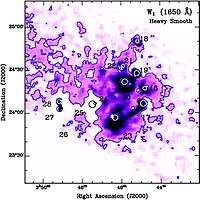
The image on the right is at 220.0 nm of the Pleiades. Each star is labeled using its number in Taurus, e.g. 23 Tau (23 Tauri) is Merope.
"The stars 20 Tau (Maia), 23 Tau (Merope), and 25 Tau (Alcyone) have prominent nebular glows".[4]
Even at higher energies as in the image on the left, "The stellar halos merge into a diffuse nebular glow like that seen in photographs, but the faint outer nebulosity remains undetected. The UV nebular intensities are generally less than might be expected from optical intensities and the UV brightness of the illuminating stars."[4]
Opticals
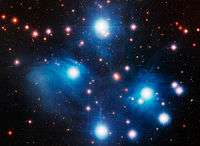
"Until the 1990s, the consensus was that the Pleiades are about 430 light-years from Earth. However, the European satellite Hipparcos, launched in 1989 to precisely measure the positions and distances of thousands of stars, produced a distance measurement of only about 390 light-years."[5]
Infrareds
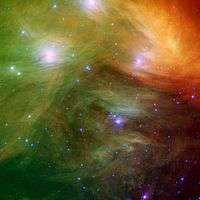
"The Seven Sisters, also known as the Pleiades, seem to float on a bed of feathers in a new infrared image [on the right] from NASA's Spitzer Space Telescope. Clouds of dust sweep around the stars, swaddling them in a cushiony veil."[6]
"The Pleiades, located more than 400 light-years away in the Taurus constellation, are the subject of many legends and writings. Greek mythology holds that the flock of stars was transformed into celestial doves by Zeus to save them from a pursuant Orion. The 19th-century poet Alfred Lord Tennyson described them as "glittering like a swarm of fireflies tangled in a silver braid."[6]
"The star cluster was born when dinosaurs still roamed the Earth, about one hundred million years ago. It is significantly younger than our 5-billion-year-old sun. The brightest members of the cluster, also the highest-mass stars, are known in Greek mythology as two parents, Atlas and Pleione, and their seven daughters, Alcyone, Electra, Maia, Merope, Taygeta, Celaeno and Asterope. There are thousands of additional lower-mass members, including many stars like our sun. Some scientists believe that our sun grew up in a crowded region like the Pleiades, before migrating to its present, more isolated home."[6]
"The new infrared image from Spitzer highlights the "tangled silver braid" mentioned in the poem by Tennyson. This spider-web like network of filaments, colored yellow, green and red in this view, is made up of dust associated with the cloud through which the cluster is traveling. The densest portion of the cloud appears in yellow and red, and the more diffuse outskirts appear in green hues. One of the parent stars, Atlas, can be seen at the bottom, while six of the sisters are visible at top."[6]
Infrared 4.5 µm (blue) from the Spitzer IRAC, Infrared 8.0 µm (green) from the Spitzer IRAC, and Infrared 24.0 µm (red) from the Spitzer MIPS are the colors in the image used to represent these wavelengths.[6]
Radios
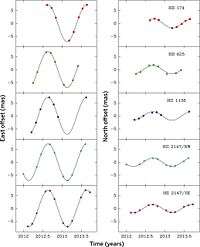
A "global network of radio telescopes [can be used] to make the most accurate possible distance measurement. The network included the Very Long Baseline Array (VLBA), a system of 10 radio telescopes ranging from Hawaii to the Virgin Islands; the Robert C. Byrd Green Bank Telescope in West Virginia; the 1,000-foot-diameter William E. Gordon Telescope of the Arecibo Observatory in Puerto Rico; and the Effelsberg Radio Telescope in Germany."[5]
"Using these telescopes working together, we had the equivalent of a telescope the size of the Earth. That gave us the ability to make extremely accurate position measurements -- the equivalent of measuring the thickness of a quarter in Los Angeles as seen from New York."[7]
"The astronomers used this system to observe several Pleiades stars over about a year and a half to precisely measure the apparent shift in each star's position caused by the Earth's rotation around the Sun. Seen at opposite ends of the Earth's orbit, a star appears to move slightly against the backdrop of more-distant cosmic objects. Called parallax, the technique is the most accurate distance-measuring method astronomers have, and relies on simple trigonometry."[5]
A "distance to the Pleiades [was determined] of 443 light-years, accurate [...] to within one percent. This is the most accurate and precise measurement yet made of the Pleiades distance."[5]
"Radio-telescope systems such as the one we used for the Pleiades will provide a crucial cross-check to insure the accuracy of Gaia's measurements."[8]
"Now we've used a system that provides modern astronomy's sharpest 'vision' to solve a longstanding scientific debate about the Pleiades themselves."[9]
"For each object [measured in the image on the right] the solid line is the best-fitting astrometric model that includes proper motion and parallax; the proper motion has been removed in the data points to accentuate the parallax motion. For each component of the HII 2147 binary system and for HII 1136 we additionally include acceleration terms in our fit to model short segments of a binary orbit (the average angular separation between the two stars of the HII 2147 system over the monitoring period [...] is ≈60 milliarcseconds or ≈8.2 AU in projection). The left-hand panel curves and data points show East (right ascension times cos(declination)) angular offsets on the sky of the source position relative to a distant quasar. The right-hand panel curves and data points show North (declination) offsets. Each source is color-coded and labeled in the declination panels."[10]
Stars
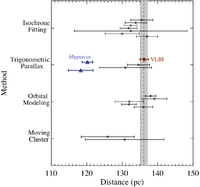
The graph on the right "summarizes distances obtained for the Pleiades cluster to date, including the new measurement described here. As can be seen, most measurements are in rough agreement with that produced in this work, with the stark exception of the Hipparcos astrometric satellite distances. For a single object near the distance of the Pleiades, Hipparcos was not capable of producing a distance measurement with accuracy better than 10%. However, by taking the aggregate of many cluster members, Hipparcos was able to achieve a Pleiades parallax with roughly 1% precision (6, 7). In almost any other case, one would simply discard the disagreeable Hipparcos cluster distances as bad measurements, but the Hipparcos mission represents the most complete astrometric survey of the sky and of the Pleiades cluster to date. It provides a path that is free of stellar physical models to obtaining the cluster distance and combines more than 50 cluster-member distance measurements. Other methods either include at most several cluster members in their distance determination, rely heavily on physical models to obtain a cluster distance (whereas it should be the distance measurement that informs the development of physical models), or result in large uncertainties in the cluster distance."[10]
11 Tauri
11 Tauri, HIP 17181 (TYC 1803-1582-1), has a 1997 parallax of 6.24 ± 0.93, according to VizieR. Its 2007 reduction parallax is 6.83 ± 0.50 per SIMBAD. The spectral type is A2IV (SIMBAD).
16 Tauri
16 Tauri (Celaeno), HIP 17489 (TYC 1799-1440-1), has a 1997 parallax of 9.75 ± 1.05, according to VizieR. Its 2007 reduction parallax is 8.65 ± 0.36 per SIMBAD. The spectral type is B7IV (SIMBAD).
17 Tauri
17 Tauri (Electra), HIP 17499 (TYC 1799-1441-1), has a 1997 parallax of 8.80 ± 0.89, according to VizieR. Its 2007 reduction parallax is 8.06 ± 0.25 per SIMBAD. The spectral type is B6IIIe (SIMBAD).
18 Tauri
18 Tauri, HIP 17527 (TYC 1803-1583-1), has a 1997 parallax of 8.87 ± 0.89, according to VizieR. Its 2007 reduction parallax is 7.97 ± 0.37 per SIMBAD. The spectral type is B8V (SIMBAD).
19 Tauri
19 Tauri (Taygeta, q Tau), HIP 17531 (TYC 1803-1585-1), has a 1997 parallax of 8.75 ± 1.08, according to VizieR. Its 2007 reduction parallax is 7.97 ± 0.33 per SIMBAD. The spectral type is B6IV (SIMBAD).
20 Tauri
According to SIMBAD, 20 Tauri (Maia) is also designated as Hipparcos, or HIP, 17573. The parallax measurements by Hipparcos of 20 Tau are recorded in "Vol 5: The Hipparcos Catalogue -- RA: 0h-4h, HIP: 1-18677".[11]
Its spectral type is B8III (SIMBAD).
According to VizieR, in the 1997 catalogue, HIP 17573 has a parallax of 9.06 mas ± 1.03 mas. Whereas, according to SMBAD, in the 2007 reduction, its parallax is 8.51 mas ± 0.28 mas.
21 Tauri
21 Tauri (Asterope), HIP 17579 (TYC 1803-1584-1), has a 1997 parallax of 8.43 ± 0.89, according to VizieR. Its 2007 reduction parallax is 8.77 ± 0.54 per SIMBAD. The spectral type is B8V (SIMBAD).
22 Tauri
22 Tauri, HIP 17588 (TYC 1804-2521-1), has a 1997 parallax of 9.21 ± 0.92, according to VizieR. Its 2007 reduction parallax is 8.58 ± 0.56 per SIMBAD. The spectral type is A0Vn (SIMBAD).
23 Tauri
23 Tauri (V971 Tau), HIP 17608 (TYC 1800-2204-1), has a 1997 parallax of 9.08 ± 1.04, according to VizieR. Its 2007 reduction parallax is 8.58 ± 0.37 per SIMBAD. The spectral type is B6IVe (SIMBAD).
24 Tauri
24 Tauri, HIP 17702 (TYC 1800-2201-1), has a 1997 parallax of 8.87 ± 0.99, according to VizieR. Its 2007 reduction parallax is 8.09 ± 0.42 per VizieR, which is considered faulty by SIMBAD. See 25 Tauri. The spectral type is A0V (SIMBAD), with parallax of 6.4 ± 18.5.
25 Tauri
25 Tauri (Alcyone, eta Tau), HIP 17702 (TYC 1800-2201-1), has a 1997 parallax of 8.87 ± 0.99, according to VizieR. Its 2007 reduction parallax is 8.09 ± 0.42 per SIMBAD. The spectral type is B7III (SIMBAD).
26 Tauri
26 Tauri, HIP 17832 (TYC 1800-2205-1), has a 1997 parallax of 13.44 ± 0.97, according to VizieR. Its 2007 reduction parallax is 13.22 ± 0.52 per SIMBAD. The spectral type is F0 (SIMBAD).
27 Tauri
27 Tauri (Atlas), HIP 17847 (TYC 1800-2203-1), has a 1997 parallax of 8.57 ± 1.03, according to VizieR. Its 2007 reduction parallax is 8.53 ± 0.39 per SIMBAD. The spectral type is B8III (SIMBAD).
28 Tauri
28 Tauri (Atlas), HIP 17851 (TYC 1800-2200-1), has a 1997 parallax of 8.42 ± 8.42, according to VizieR. Its 2007 reduction parallax is 8.54 ± 0.31 per SIMBAD. The spectral type is B8Vne (SIMBAD).
V382 Tauri
The variable star V382 Tau (HII 3030) is not in either Hipparcos or Tycho catalogues. Its parallax was not measured by Hipparcos. The absolute parallax for V382 (HII 3030) is "7.41 ± 0.18" mas.[12]
It is spectral type K9V (SIMBAD).
V677 Tauri
V* V677 Tau (HII 3063) has not had its parallax measured by Hipparcos. Its absolute parallas is "7.43 ± 0.16" mas.[12] Its spectral type is K6V (SIMBAD).
V811 Tauri
The variable star V811 Tau (HII 625) is not in either Hipparcos or Tycho catalogues. Its parallax was not measured by Hipparcos.
It is spectral type G5 (SIMBAD).
V1065 Tauri
The variable star V1065 Tau (HII 1136) was not measured by Hipparcos. It is spectral type G7V (SIMBAD).
V1271 Tauri
The variable star 1271 Tau is also Tycho (TYC) catalogue TYC 1803-8-1. But, according to VizieR, the parallax of this star (HII 174) was apparently not measured by Hipparcos.
"The measured distances and +/−1 [standard deviation] SD errors for the four systems are 134.8 ± 0.5 pc (HII 174), 138.4 ± 1.1 pc (HII 625), 135.5 ± 0.6 pc (HII 1136), and 136.6 ± 0.6 pc (HII 2147 system)."[10]
V1282 Tauri
V* V1282 Tau (HII 2147) has a Tycho catalogue designation of TYC 1800-1091-1. But, its parallax was not measured by Hipparcos.
It is spectral type G7IV (SIMBAD).
HD 23753
HD 23753 (HR 1172), HIP 17776 (TYC 1800-2207-1), has a 1997 parallax of 9.64 ± 0.91, according to VizieR. Its 2007 reduction parallax is 8.45 ± 0.39 per SIMBAD. The spectral type is B8V (SIMBAD).
HD 23923
HD 23923 (HR 1183), HIP 17900 (TYC 1800-2207-1), has a 1997 parallax of 8.58 ± 0.93, according to VizieR. Its 2007 reduction parallax is 8.72 ± 0.60 per SIMBAD. The spectral type is B8V (SIMBAD).
HD 24194
HD 24194 (HII 3179) has not had its parallax measured by Hipparcos. Its absolute parallax is "7.45 ± 0.16" mas.[12]
HD 24802
HD 24802 (HR 1222), HIP 18508 (TYC 1817-176-1), has a 1997 parallax of 3.04 ± 0.92, according to VizieR. Its 2007 reduction parallax is 3.13 ± 0.97 per SIMBAD. The spectral type is K0 (SIMBAD).
Star clusters
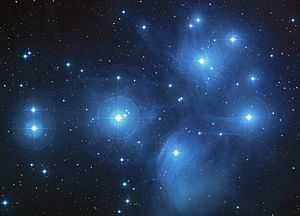
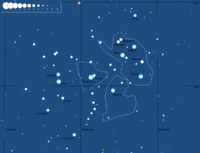
Messier 45 is an open galactic cluster of stars. It is also called the Pleiades and the Seven Sisters.
According to SIMBAD, the Pleiades have been detected by HEAO 1 as an X-ray source.
"The brilliant stars seen in this image [on the right] are members of the popular open star cluster known as the Pleiades, or Seven Sisters. The Hubble Space Telescope's Fine Guidance Sensors refined the distance to the Pleiades at about 440 light-years. The Fine Guidance Sensors are at the periphery of Hubble's field-of-view. They trace a circumference that is approximately the angular size of the Moon on the sky. They are overlaid on this image to give a scale to Hubble's very narrow view on the heavens."[13]
"Hubble Fine Guidance Sensors measured slight changes in the apparent positions of three stars within the cluster when viewed from different sides of Earth's orbit. Astronomers took their measurements six months apart over a 2 1/2-year period. About 1,000 stars comprise the cluster, located in the constellation Taurus."[13]
"The color-composite image of the Pleiades star cluster was taken by the Palomar 48-inch Schmidt telescope. The image is from the second Palomar Observatory Sky Survey, and is part of the Digitized Sky Survey. The Pleiades photo was made from three separate images taken in red, green, and blue filters. The separate images were taken between Nov. 5, 1986 and Sept. 11, 1996."[13]
On the left is a celestial map of the Pleiades with some of the stars named and their dust clouds outlined. Star magnitudes are indicated by circle sizes.
Astromathematics
"For each object in our sample, we conducted astrometric fits to the measured positions to extract stellar parallaxes. Only data taken in 2012-2013 were used for HII 1136 to ensure consistent and readily comparable results. Measured positions are modeled with the sum of a parallax sinusoid (determined by the parallax magnitude – π – and the purely geometrical motion for a given part of the sky induced by Earth’s orbit), a reference position at an arbitrarily chosen fixed epoch, and a linear or accelerated proper motion (μαcosδ, μδ, aαcosδ, and aδ; acceleration terms account for binary motion when the orbital period is much larger than the time frame over which the system was monitored and have been successfully used in past attempts to measure system parallaxes, see ref. 16). This results in five or seven fitted model parameters. During the fitting process the data are weighted using the quadrature sum of the formal measured fit uncertainties and an additional component that represents systematic uncertainties. A least squares fitting routine determines the parameters that minimize the sum of the squares of the residuals. This process allows the systematic error component to be adjusted as necessary to obtain a χ2 equal to 1 for each of the R.A. and Decl. data. The fitted proper motions can be compared with the values shown in second and third columns that were previously determined from optical measurements. All uncertainties are ±1 SD."[10]
Research
Hypothesis:
- The optical parallax measurements made by Hipparchus had an error large in comparison with the distance measured to the Pleiades.
- A spherical galactic star cluster of ~ 3000 stars separated by an average distance of 4 lyrs would be about 60 lyrs in diameter.
- The stars measured for radio parallaxes are at the farther side of the cluster whereas those measured for optical parallaxes are at the nearer side of the cluster.
Control groups

The findings demonstrate a statistically systematic change from the status quo or the control group.
“In the design of experiments, treatments [or special properties or characteristics] are applied to [or observed in] experimental units in the treatment group(s).[14] In comparative experiments, members of the complementary group, the control group, receive either no treatment or a standard treatment.[15]"[16]
Proof of concept
Def. a “short and/or incomplete realization of a certain method or idea to demonstrate its feasibility"[17] is called a proof of concept.
Def. evidence that demonstrates that a concept is possible is called proof of concept.
The proof-of-concept structure consists of
- background,
- procedures,
- findings, and
- interpretation.[18]
Proof of technology
"[T]he objective of a proof of technology is to determine the solution to some technical problem, such as how two systems might be integrated or that a certain throughput can be achieved with a given configuration."[19]
Def.
- "[a]n original object or form which is a basis for other objects, forms, or for its models and generalizations",[20]
- "[a]n early sample or model built to test a concept or process",[20] or
- "[a]n instance of a category or a concept that combines its most representative attributes"[20] is called a prototype.
Def. "[t]o test something using the conditions that it was designed to operate under, especially out in the real world instead of in a laboratory or workshop"[21] is called "field-test", or a field test.
A "proof-of-technology prototype ... typically implements one critical scenario to exercise or stress the highest-priority requirements."[22]
"[A] proof-of-technology test demonstrates the system can be used"[23].
"The strongest proof of technology performance is based on consistency among multiple lines of evidence, all pointing to similar levels of risk reduction."[24]
See also
References
- ↑ "parallax, In: Wiktionary". San Francisco, California: Wikimedia Foundation, Inc. 8 December 2015. Retrieved 2016-01-13.
- 1 2 3 Haywood Smith, Jr and Heinrich Eichhorn (1996). "On the estimation of distances from trigonometric parallaxes". Monthly Notices of the Royal Astronomical Society 281 (1): 211-18. http://mnras.oxfordjournals.org/content/281/1/211.short. Retrieved 2014-04-18.
- ↑ Robert Nemiroff & Jerry Bonnell (28 August 1999). "X-Ray Pleiades". Washington, DC USA: NASA. Retrieved 2016-01-13.
- 1 2 Steven J. Gibson and Kenneth H. Nordsieck (20 May 2003). "The Pleiades Reflection Nebula. I. Ultraviolet, Optical, and Far-Infrared Imaging Photometry". The Astrophysical Journal 589 (01): 347-61. doi:10.1086/374589. http://iopscience.iop.org/article/10.1086/374589/fulltext/. Retrieved 2016-01-14.
- 1 2 3 4 Dave Finley (28 August 2014). "Radio Telescopes Settle Controversy Over Distance to Pleiades". National Radio Telescope Observatory. Retrieved 2016-01-12.
- 1 2 3 4 5 John Stauffer (12 April 2007). "The Seven Sisters Pose for Spitzer". Retrieved 2016-01-13.
- ↑ Amy Miouduszewski (28 August 2014). "Radio Telescopes Settle Controversy Over Distance to Pleiades". National Radio Telescope Observatory. Retrieved 2016-01-12.
- ↑ Mark Reid (28 August 2014). "Radio Telescopes Settle Controversy Over Distance to Pleiades". National Radio Telescope Observatory. Retrieved 2016-01-12.
- ↑ Carl Melis (28 August 2014). "Radio Telescopes Settle Controversy Over Distance to Pleiades". National Radio Telescope Observatory. Retrieved 2016-01-12.
- 1 2 3 4 Carl Melis, Mark J. Reid, Amy J. Mioduszewski, John R. Stauffer, and Geoffrey C. Bower (29 August 2014). "A VLBI Resolution of the Pleiades Distance Controversy". Science 345 (6200): 1029-32. http://science.sciencemag.org/content/345/6200/1029.full. Retrieved 2016-01-14.
- ↑ Lennart Lindegren and Jean Kovalevsky (June 1997). "The Hipparcos and Tycho Catalogues". ESA SP-1200. ESA. Retrieved 2016-01-14.
- 1 2 3 David R. Soderblom and Ed Nelan, G. Fritz Benedict, Barbara McArthur, Ivan Ramirez, and William Spiesman, and Burton F. Jones (March 2005). "Confirmation of Errors in Hipparcos Parallaxes from Hubble Space Telescope Fine Guidance Sensor Astrometry of the Pleiades". The Astronomical Journal 129 (3): 1616-24. doi:10.1086/427860. http://adsabs.harvard.edu/abs/2005AJ....129.1616S. Retrieved 2016-01-16.
- 1 2 3 NASA, ESA and AURA/Caltech (1 June 2004). "Hubble Refines Distance to Pleiades Star Cluster". Baltimore, Maryland USA: Hubblesite. Retrieved 2016-01-13.
- ↑ Klaus Hinkelmann, Oscar Kempthorne (2008). Design and Analysis of Experiments, Volume I: Introduction to Experimental Design (2nd ed.). Wiley. ISBN 978-0-471-72756-9. http://books.google.com/?id=T3wWj2kVYZgC&printsec=frontcover.
- ↑ R. A. Bailey (2008). Design of comparative experiments. Cambridge University Press. ISBN 978-0-521-68357-9. http://www.cambridge.org/uk/catalogue/catalogue.asp?isbn=9780521683579.
- ↑ "Treatment and control groups, In: Wikipedia". San Francisco, California: Wikimedia Foundation, Inc. May 18, 2012. Retrieved 2012-05-31.
- ↑ "proof of concept, In: Wiktionary". San Francisco, California: Wikimedia Foundation, Inc. November 10, 2012. Retrieved 2013-01-13.
- ↑ Ginger Lehrman and Ian B Hogue, Sarah Palmer, Cheryl Jennings, Celsa A Spina, Ann Wiegand, Alan L Landay, Robert W Coombs, Douglas D Richman, John W Mellors, John M Coffin, Ronald J Bosch, David M Margolis (August 13, 2005). "Depletion of latent HIV-1 infection in vivo: a proof-of-concept study". Lancet 366 (9485): 549-55. doi:10.1016/S0140-6736(05)67098-5. http://www.ncbi.nlm.nih.gov/pmc/articles/PMC1894952/. Retrieved 2012-05-09.
- ↑ "Proof of concept, In: Wikipedia". San Francisco, California: Wikimedia Foundation, Inc. December 27, 2012. Retrieved 2013-01-13.
- 1 2 3 "prototype, In: Wiktionary". San Francisco, California: Wikimedia Foundation, Inc. December 8, 2013. Retrieved 2014-01-03.
- ↑ "field-test, In: Wiktionary". San Francisco, California: Wikimedia Foundation, Inc. August 5, 2012. Retrieved 2013-01-13.
- ↑ A. Liu; I. Gorton (March/April 2003). "Accelerating COTS middleware acquisition: the i-Mate process". Software, IEEE 20 (2): 72-9. doi:10.1109/MS.2003.1184171. http://cin.ufpe.br/~redis/intranet/bibliography/middleware/liu-cots03.pdf. Retrieved 2012-02-15.
- ↑ Rhea Wessel (January 25, 2008). "Cargo-Tracking System Combines RFID, Sensors, GSM and Satellite". RFID Journal: 1-2. http://www.rfidjournal.com/article/pdf/3870/1/1/rfidjournal-article3870.PDF. Retrieved 2012-02-15.
- ↑ P. Suresh, C. Rao, M.D. Annable and J.W. Jawitz (August 2000). E. Timothy Oppelt. ed. [http://www.afcee.af.mil/shared/media/document/AFD-071003-081.pdf#page=108 In Situ Flushing for Enhanced NAPL Site Remediation: Metrics for Performance Assessment, In: Abiotic In Situ Technologies for Groundwater Remediation Conference]. Cincinnati, Ohio: U.S. Environmental Protection Agency. pp. 105. http://www.afcee.af.mil/shared/media/document/AFD-071003-081.pdf#page=108. Retrieved 2012-02-15.
External links
- The SAO/NASA Astrophysics Data System
- SIMBAD Astronomical Database
- SIMBAD Web interface, Harvard alternate
- VizieR for I/239/hip_main The Hipparcos and Tycho Catalogues (ESA 1997)
![]() This is a research project at http://en.wikiversity.org
This is a research project at http://en.wikiversity.org
| |
Development status: this resource is experimental in nature. |
| |
Educational level: this is a research resource. |
| |
Resource type: this resource is an article. |
| |
Resource type: this resource contains a lecture or lecture notes. |
| |
Subject classification: this is an astronomy resource. |